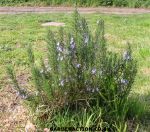Rosemary
(Rosmarinus officinalis)
Now that I’ve reviewed my notes on rosemary, I can see why so many people are muscle-testing that they need it for the winter season! It really tastes great in soups and stews. Michael and I have been using quite a bit of it these last few months. I think I’ll make a garland out of it next summer. You’ll see why. Enjoy.
Photos of Rosemary:
Picture References https://www.hickerphoto.com/rosemary-blooms-provence-11471-pictures.htm
Rosemary has even been used as Bonsai trees:
Picture Reference: https://balconyofdreams.blogspot.com/2009/07/edible-plants-to-replace-typical.html
History: Native to the Mediterranean, rosemary grows freely in much of southern Europe and is now cultivated around the world. Rosemary (Rosmarinus officinalis) is an aromatic evergreen bush with silvery green leaves and pale blue flowers. It still is burned in the homes of students living in Greece who are about to take exams. Greek scholars used to wear rosemary garlands in their hair during exam times to improve memory and concentration. Rosemary is used as a symbol of friendship, loyalty and remembrance and is traditionally carried by mourners at funerals and by the bride at her wedding. We plant rosemary around the perimeter of our property to “ward off negative spirits” (we think it really works!)
Rosemary is a warming herb containing volatile oils such as camphor, flavonoids (even stronger than rutin), tannins, rosemarinic acid (a mild analgesic), diterpenes and rosmaricine.
Rosemary is propagated by seeds (early spring) or cuttings (mid-summer after blooming) preferring warm, moderately dry and sheltered climates. Rosemary grows well in containers and is easily trained into topiary. Prune after flowering to promote bushy growth. Plants can be stored in green houses or inside during the winter in climates that freeze. Make sure there is enough air circulation to prevent mildew from growing on the plant.
Uses for Rosemary:
- Acne and eczema
- Aids in recovery from long-term stress and chronic illness by supporting adrenal function
- Analgesic—because of this it can be used in the place of aspirin
- Antifungal
- Anti-inflammatory (it can be added to oils and lotions to help aching and rheumatism)
- Antiseptic—kills many different bacteria
- Astringent—good for fluid retention
- Carminative—soothes the gut
- Constipation
- Depression (mild to moderate)
- Diaphoretic (causes sweating)
- Digestive complaints including indigestion, colic, nausea, and gas
- Digestive problems associated with anxiety
- Eases headaches and migraines
- Encourages hair growth by improving circulation to the scalp (the essential oil is included in many natural hair conditioners)
- Epilepsy
- Failure to Thrive syndrome caused from stress
- Fever
- Improves concentration and mental clarity
- Lice
- Menstrual cramps (calms the muscles and reduces muscle spasm)
- Mental exhaustion
- Mucolytic (helps move mucous associated with colds/flu)
- Nervine—Rosemary contains lots of bioavailable calcium which calms the nerves
- Raises low blood pressure (used for fainting and weakness associated with poor circulation)
- Raises the spirits
- Relaxes spasms
- Skin toner
- Stimulates blood flow to the brain so is good for memory, epileptics, and people who suffer from migraines
- Stimulates liver and gallbladder to improve digestion
- Strengthens capillaries
- Strengthens memory!
- Tonic
- Toxic Shock Syndrome
- Used as a symbol of fidelity between lovers so it is often put in the bridal bouquet
- Used to flavor meats, soups, stews, sauces, salad dressings, breads and some jams.
- Vertigo
Harvesting and Care of Rosemary:
Branches are harvested after flowering and dried in the shade. The dried needles (leaves) are picked off and used in cooking and in making teas and infusions. Fresh plants are used for making essential oils. Starwest Botanical organic essential oil can be used internally as well as externally, but you can find it under other brand names as well. The cost is about $4.10 for a 1/3 ounce bottle (about the cost of a couple of baby plants.) Order from www.starwest-botanicals.com
To make rosemary tea add ½ ounce fresh rosemary to a pint of boiling water, steep in a covered container for 10 minutes and drink or use the cooled tea in hair rinses.
Rosemary tincture (also called Hungary water) is made by macerating rosemary tops and letting them soak in alcohol for about a month.
Rosemary essential oil is added to lotions, carrier oils (such as peanut, castor or olive) is used externally for rheumatism, arthritis, neuralgia, muscular injuries, wounds, and dandruff. Peanut oil is especially healing for joints and castor oil draws out toxins from the system—both great choices for arthritis.
Precautions and Contraindications for Rosemary: Excess rosemary is not safe for pregnant women (may cause abortion in the first three months of pregnancy because it is too stimulating) and for those with high blood pressure. Using it in normal amounts in recipes should be fine unless you have an allergy to it (which I’ve never heard of yet.) Using too much over an extended period of time, it may cause convulsions in people who are prone to them (small amounts stimulate the circulation and help some epileptics).
Best not used before bedtime as it may keep one awake.
Helpful Links & References:


